It was a surreal experience to present at the IBBY World Congress on the 18th of August 2016 at the Aotea Centre. The organisers put together an amazing event with so much choice for all participants. We were lucky to have such a good turn out to our presentation on ‘The Life of Today’s Book Designer’.
Our whole team spent weeks preparing and practicing and most of all encouraging Kim as a presenter. The final product was a job well done by everyone.
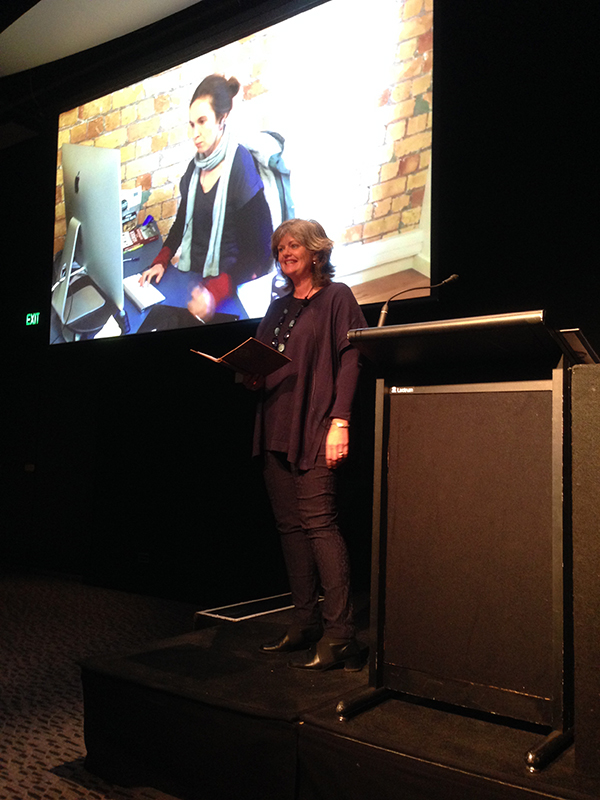
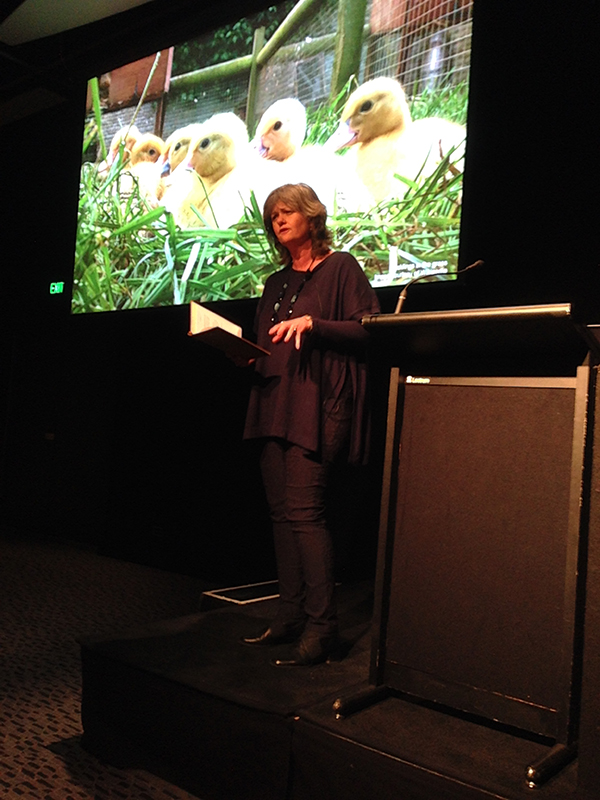

Here’s a sneak at our slide show and a transcript of Kim’s speech. If you want to see this live we are happy to present it again. Just drop us a line.
The Life of Today’s Book Designer
Presented by Kim Dovey
IBBY World Congress 2016
If I was to show you the life of a book designer for the next 20 minutes, you’d be very bored. What you’d see is what we do all day. Just sitting at our desk, staring at the screen. From the outside we are shut off from the world. Occasionally we look up and go in search of food or drink, although from my experience, that’s not often.
This 20 minutes will be much more interesting if instead I tell you about my experience with books and the passion that drives me to come to work each day.
You see … As a girl I had a groups of friends.
We were inseparable.
We’d scour the countryside in and around Christchurch in search of adventure.
Without them my childhood would have been very boring, and my adult life view of the world and ways of coping have been shaped, in part, by these bunch of kids.
I don’t remember even one of them ever opening a book…
Too much to be done…Too much to be explored and conquered … and I always wanted a dog.

It wasn’t until I was in my thirties though that I got my Timmy. A wild, strong headed and very loyal Bearded Collie.
And it’s not until now in my later 40’s that I am beginning to realise why when I got to choose my own dog, I didn’t want a labrador.
Have you heard about imprinting – not on a book, but on the brain? Konrad Lorenz was a researcher that did a study with baby ducklings. The ducklings all assumed that the researcher was their mother, as he was first thing they saw when they came out of their shells.
The recent resurgence of Pokemon, in the form of an augmented reality game, plays to this same phenomenon.

Image courtesy of Mashable
My children were obsessed with Pokemon when they were kids, and I’m amazed to see now that now in their early 20’s, they still have the desire that makes them ‘gotta catch’em all’. It’s as if there’s been some dormant childhood imprint that has been reactivated with the combination of a favourite memory and their beloved screen.
Or maybe I could flatter myself and add in the imprint of my continual nagging to get outside and go play.
Pokemon’s original popularity coincided with the arrival of the commercial internet in 1995 – so it should be no surprise the new game appeals to my young ‘digital natives’ – they have their noses buried, not in books, but swathed in the light of their smartphones.
You can see how the connection with technology has converged – from video games, cartoons, trading cards and an endless array of Pokemon merchandising (which I swear I have only just finished throwing out) has now become alive again with the accessibility of the smartphone, GPS and Apps.
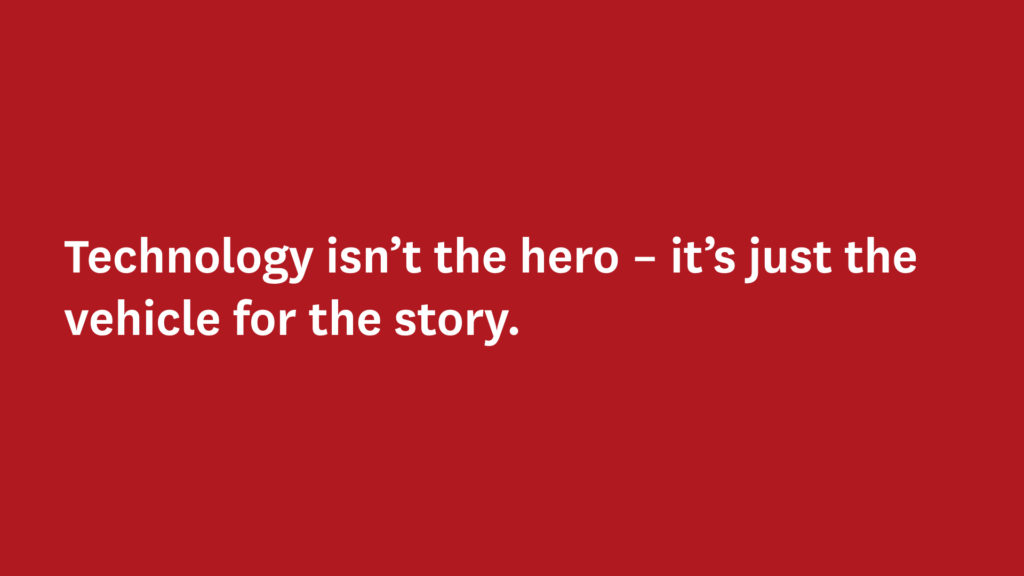
It would be easy to imagine it is technology that is the real hero of the Pokemon saga. But really it is just the vehicle for the story.
When the cavemen huddled in the flickering light of their caves with their families, the paintings on the walls told their stories of the animals they relied on for survival; what animals were good to eat or which ones were going to eat them. They may have told of the journeys and hunts that provided them with food.
They were designing the book of their survival. And using the cave wall as the technology available in their day to build communities and pass on their limited knowledge to the future generations. In the absence of science their stories were crude but mystical and a complete representation of their known universe. Like us as parents today, observing Pokemon, we have little understanding of it all.
Fast forward to the days of the Pharaohs. (Well a slow kinda fast forward, it was only – 50,000 years or so.)
There is new science and technology taking place. Farming is replacing hunting and gathering, and the Egyptians are pushing to codify and define the world, to establish authority through religious texts. They decorate utensils and structures with their extraordinarily rich graffiti. They imprinted onto technical advances such as parchment (which is just the animal hide of cows and goats) and other flexible surfaces that could be transported and stored.
The book designer in these times was known as an Illuminator; they were employed by the Priest. The Priests were the ones who could write and decode the symbols for the culture, while everyday folk were kept in the dark – only ever allowed glimpses of the richly decorated manuscripts and scrolls. The Priests made information their wealth which they protected and turned into their power.
But as this greed starts to happen a surplus is also being created – which, in turn creates the need for accounting and law – who owns what and what happens if it is stolen.
We start to see the emergence of what we now know as authority.
And what could have more authority during this time than the stories of the Gods. Those who conferred order onto the world and preserved the idea for ‘Rulers’ whom are Gods on earth. In truth these myths are nothing more than simple stories that could be told and retold, from parents to children.
We still explore and learn from these seas of imagination in much the same way as we have for generations, from the safety spot of being cuddled up on a loved one’s knee. From this spot we’ve been frightened by universal horrors with fables like the aptly named Brothers Grimm or warmed in our hearts with big friendly giants like the BFG.
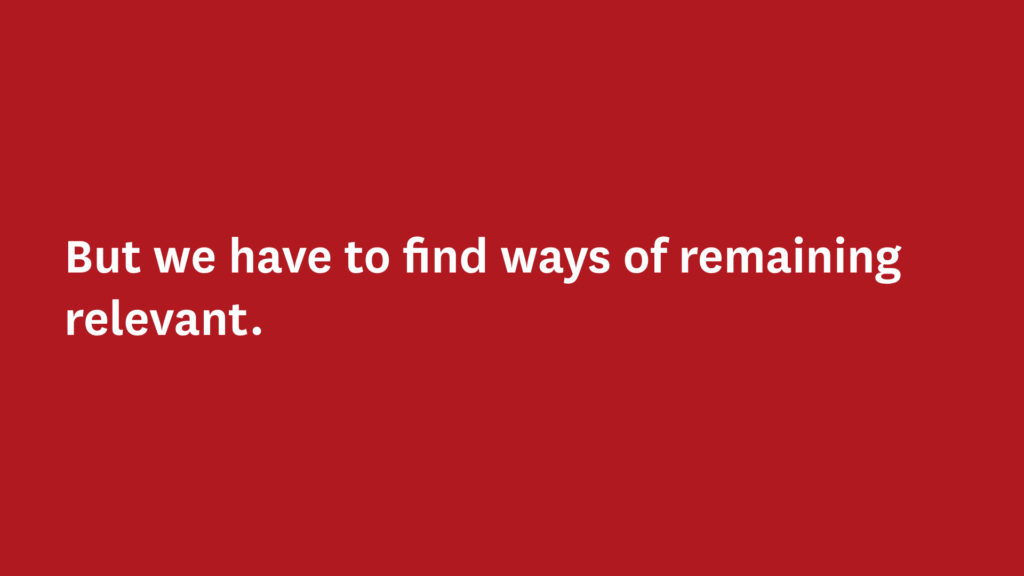
But we have to find ways of remaining relevant …we must remember that our kids are smarter than we will ever be. Their minds are plastic and have been shaped by today’s culture and their measurable intelligence is increasing with each generation – they absorb more stimulus than our grandparents could possibly imagine. Our children are going to demand a different kind of stimulus and richer degrees of immersion and involvement in the telling.
And there is no point in railing against it, wishing for the rambles of the Famous Five or the rude economy of the original BFG drawings…
We can’t turn back the tide no more than Alfred the Great in the story that reconciled the divinity of kings with the unimpeachable forces of nature.
As books designers we see ourselves as creators of experiences.
Pokemon shows us how the convergence of technology is upon us.
Does it mean we should shelve our love of books and embrace these completely new platforms? Was the popular, accessible printed book been just ‘a blip’ in technology?
It’s possible that they were a flash in the pan and, looking back from the not too distant future our kids may regard them as quaint and redundant technology – after all, if the story is the thing, then the medium doesn’t matter – it never did.
Books are a technology, whether on a cave wall a piece of cow-hide or in printed form, their stories require no more than the imagination of the reader. Books themselves, even rudimentary volumes like my beloved Famous Five, can light up an entire childhood. But they are subject to changing tastes and influences that we take into the decisions that we make.
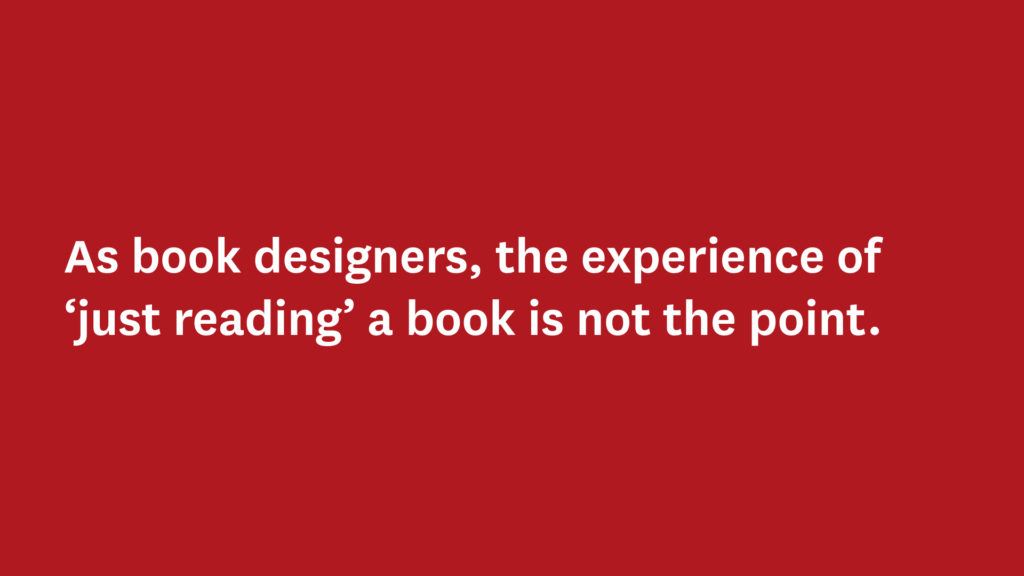
For us as book designers the experience of just ‘reading’ a book is not the point.
By immersing ourselves in the areas of balancing colours and marrying even minimal text with images we can evoke are a level of mental participation that creates the reader an experience.
With books we ‘join the dots’ in extraordinary ways.
All of our senses create a chain reaction that take us on an incredible mental journey. How many times have you sat in a movie theatre, eagerly anticipating an epic interpretation of a favourite tale, and, although the product credits are nine minutes long and have marshalled more science and craft than any book ever produced. The movie was still not you imagined your Narnia or Winterfell to be ‘really’ like…
We ‘own’ the experience of reading a book in a magical way that a movie realisation can never match.
Even the least sophisticated drawings in a picture book can have a level of interestingness that is hard to interpret in 48 frame per second. Our minds and imaginations fill in the blanks in ways that expand our own thoughts and understanding of the world. Our imaginations just don’t always want to be spoon fed… and as book designers we play a very active part in achieving this balance.
But one of the worst thing we can do as book designers is to take it as read that publishing won’t have to evolve.
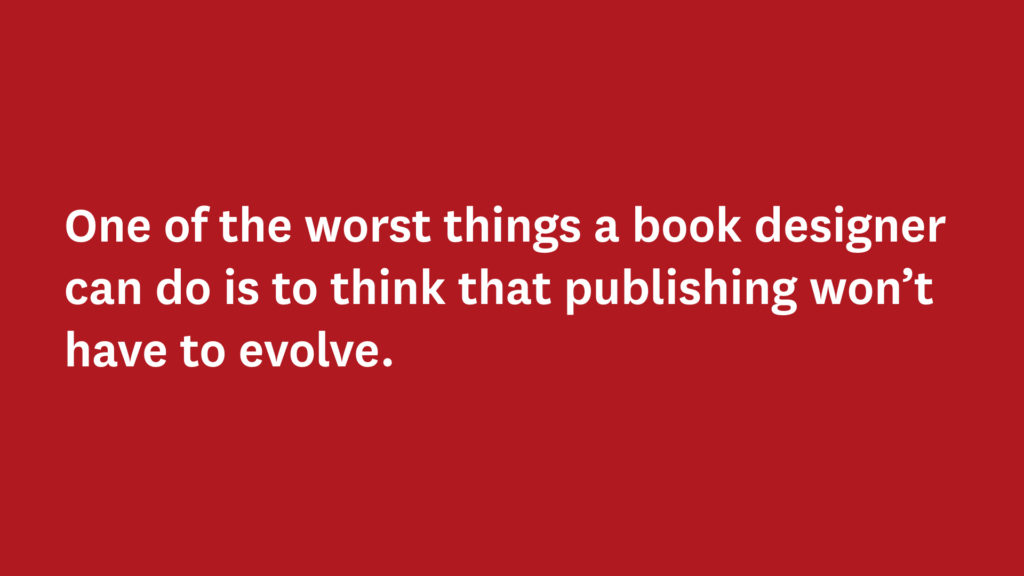
In my own studio we are exploring opportunities to take books onto their next technological advance by bridging the gap between the print and digital worlds. We call it the Magic Door Project.
The challenge we have set ourselves is to imagine what life could be possible be added to books. To create even richer experiences without either fundamentally changing the technology of the book itself or making it subject to any technological contingency – that is to say the book will function as a book in its own right. We are examining how reality can be augmented to simply to create an experience that each reader (including our children) can customise to meet their own needs and expectations of the world.
We can take a historical printed book, like the Gutenberg Bible or a folio edition of the works or Shakespeare – or even something more modern like the famous Little Yellow Digger – and offer it a new dimension and a new life – without changing a molecule on the printed page and without the need for a clumsy QR codes…
On one hand it is a simple science trick but on the other is opens a doorway into all kinds of dimensions.
We are embracing the essence of interactive – and that has infinite possibility to extend the reader’s experience.
The book in this form becomes both the door and the key that unlocks access to content.
The ubiquitous, portable, pocketable smartphone adds another dimension to the book itself – and it offers publishers the opportunity to create connections with readers and give them ‘easter eggs’ that will both surprise and delight. Whether it’s an educational textbook or a beautifully created coffee table book, the connection may come from a character or comment from the author themselves…it may be
…a reward
…a test
… a way into a community of people reading the same book at the same time and want to evoke discussion.
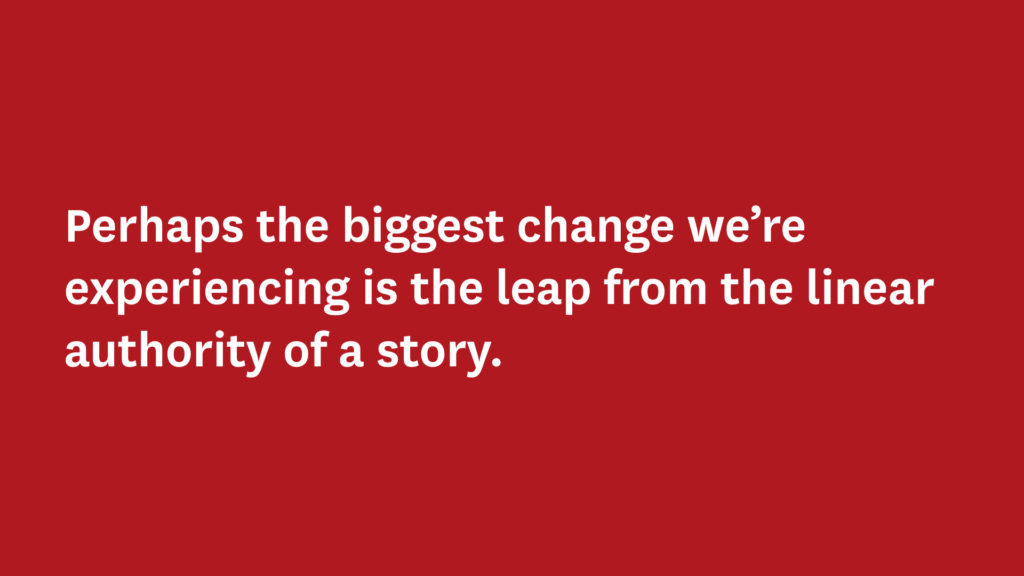
Perhaps the biggest change we experience is the leap from the linear authority of a story – the intention of the author to create a beginning, a middle and an end…
But what if every story and every book was just the beginning – and not the end. There is no full stop – we go from hieroglyph to hyperlink – we leave the page without leaving the page at all…
It stretches our imagination – and minds that have been expanded never return to their original dimensions.
If we don’t continue to think, not so much about the book, but about the impression and experience we want to offer readers, lookers and thinkers then it will be time to call it a day on the days of book design.
I, for one, can’t imagine that day.
But I always have had a very active imagination.
Thank you.
